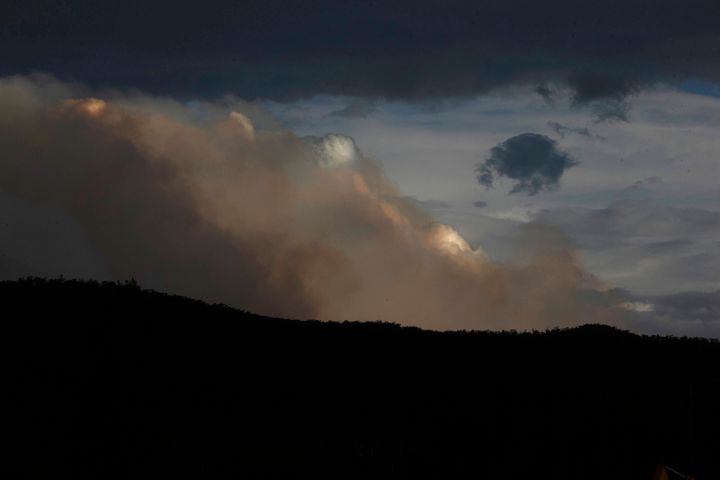
Flags in NSW flew at half mast on Friday to honour the three American firefighters who were killed after an air tanker crashed in the Snowy Monaro region of NSW while fighting bushfires.
The Canadian-owned C-130 Hercules air tanker crashed while waterbombing the alpine region on Thursday, killing all three of its crew, authorities said.
“Out of respect for the three US firefighters who lost their lives operating a Large Air Tanker, flags will fly at half mast in NSW tomorrow,” NSW Premier Gladys Berejiklian said in a Tweet on Friday.
She confirmed a February 23 state memorial will follow.
The victims were American residents, with NSW Police confirming the three men were aged aged 42, 43 and 45.
It was not immediately known why the plane crashed while carrying a load of fire retardant.
“Tragically, there appear to be no survivors as a result of the crash down in the Snowy Monaro area,” RFS Commissioner Shane Fitzsimmons told reporters on Thursday afternoon.
″(The tanker) impacted heavily with the ground and initial reports are that there was a large fireball associated with the impact of the plane as it hit the ground. There is no indication at this stage of what’s caused the accident.”
Prime Minister Scott Morrison paid his respects on Twitter calling the crash a “terrible tragedy.”
A spokesman for Australia’s Civil Aviation Safety Authority said the aircraft went into a valley to drop the retardant and did not emerge.
Fitzsimmons said the plane had been leased by Canadian aerial firefighting company Coulson Aviation, which had a second C-130 Hercules working in the Australian bushfires operation.
Coulson had grounded its large air tanker fleet following the accident, he added, pending a review to rule out any systemic issue, such as a fuel problem.
The Australian Transport Safety Bureau said it was sending a team of investigators to the crash site to collect evidence and would analyse available recorded data, review weather information and interview any witnesses.
It would take about 30 days for the release of a preliminary report, it said, but if the investigation revealed a critical safety issue it would immediately notify stakeholders.
Coulson said the plane was on a firebombing mission with a load of retardant, and added that it would send a team to the crash site to assist.

“The accident is reported to be extensive and we are deeply saddened to confirm there were three fatalities,” it said in a brief emailed statement.
The deaths take to 32 the toll from hundreds of bushfires since September. One billion animals are also estimated to have perished as the fires incinerated 2,500 homes and a total area of bushland one-third the size of Germany.
Tracking website Flightradar24 showed the path for an air tanker suddenly stopping in Peak View, south of Canberra.
According to its flight data, the aircraft departed the Richmond air force base in western Sydney around 12:15pm. It dropped off radar just after 2 pm
Peak View is close to a blaze burning out of control in the Wadbilliga National Park, the fire service said.
15,000 LITRES
The plane may have been “aerodynamically overloaded”, said Geoffrey Dell, an expert in accident forensics and investigation, meaning it may have turned or changed altitude too quickly for its load, forcing it to lose altitude sharply.
“It’s designed to operate to certain G (gravity)-limits, and if you go over those, different parts of the structure can be overstressed,” added Dell, a professor at Central Queensland University.
Such air tankers typically carry 15,000 litres of water or fire retardant for release over blazes in areas that ground crews find hard to reach.
The C-130 excels at low altitude and speeds, as its big wings and four powerful turboprop engines allow it to maneuver and accelerate in ways other aircraft cannot, said a senior US Air Force officer with more than 20 years’ experience of flying and operating the plane.
“You can make a lot of mistakes and the plane will forgive you,” said the officer, speaking on condition of anonymity because he was not authorised to speak to the media.
“It’s really perfect for these kinds of missions,” he said, referring to firefighting.
Australia’s usually temperate mountain region has escaped some of the more devastating fires that have razed more than 11 million hectares of the country’s wilderness, fanned by high winds and searing temperatures.
Canberra shut its airport for several hours on Thursday because of a fire threat, while many residents were forced to seek shelter as fires raged nearby. Passengers have been warned to check flights today as there is a backlog of customers who will need to be accommodated after Thursday’s airport closure.
Damaging winds are fanning flames in parts of the Gippsland area in the southeastern state of Victoria, authorities said, near the site of fires in December.
Sonali Paul, Colin Packham and Byron Kaye of Reuters contributed to this report.